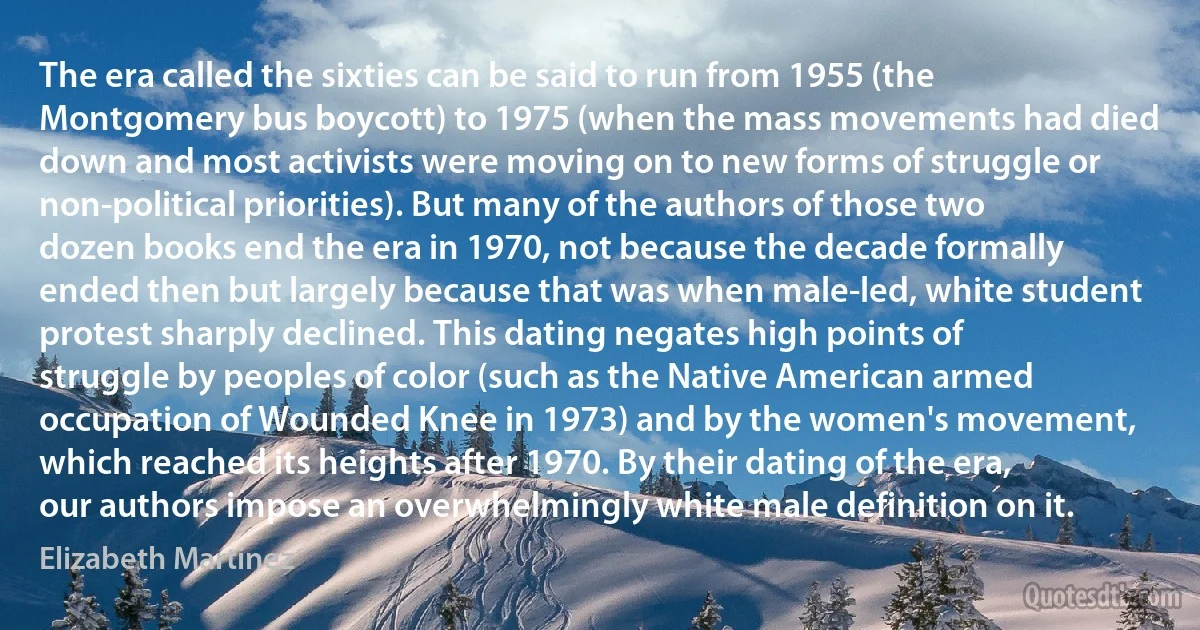
The era called the sixties can be said to run from 1955 (the Montgomery bus boycott) to 1975 (when the mass movements had died down and most activists were moving on to new forms of struggle or non-political priorities). But many of the authors of those two dozen books end the era in 1970, not because the decade formally ended then but largely because that was when male-led, white student protest sharply declined. This dating negates high points of struggle by peoples of color (such as the Native American armed occupation of Wounded Knee in 1973) and by the women's movement, which reached its heights after 1970. By their dating of the era, our authors impose an overwhelmingly white male definition on it.
Elizabeth MartinezRelated topics
boycott color dating definition dozen end era high impose male mass moving run say sixties white peoples pointsRelated quotes
The state of international relations in the sixteenth century is hardly conceivable at this day. The Puritans of England and the Huguenots of France regarded Spain as their natural enemy, and on the high seas and in the British Channel they joined hands with godless freebooters to rifle her ships, kill her sailors, or throw them alive into the sea. Spain on her side seized English Protestant sailors who ventured into her ports, and burned them as heretics, or consigned them to a living death in the dungeons of the Inquisition. Yet in the latter half of the century these mutual outrages went on for years while the nations professed to be at peace. There was complaint, protest, and occasional menace, but no redress, and no declaration of war.

Francis Parkman
We shall not flag or fail. We shall go on to the end. We shall fight in France, we shall fight on the seas and the oceans, we shall fight with growing confidence and growing strength in the air, we shall defend our island, whatever the cost may be. We shall fight on the beaches, we shall fight on the landing grounds, we shall fight in the fields and in the streets, we shall fight in the hills we shall never surrender.... And if, which I do not for a moment believe, this island or a large part of it were subjugated and starving, then our empires beyond the seas, armed and guarded by the British Fleet, will carry on the fight, until in Gods own time the new world in its power and might steps forth to the rescue and liberation of the old.

Winston Churchill
If you have weapons, take them home; if you do not have them, please do not seek to get them. We cannot solve this problem through retaliatory violence. We must meet violence with nonviolence. Remember the words of Jesus: «He who lives by the sword will perish by the sword.» We must love our white brothers, no matter what they do to us. We must make them know that we love them. Jesus still cries out in words that echo across the centuries: «Love your enemies; bless them that curse you; pray for them that despitefully use you.» This is what we must live by. We must meet hate with love. Remember, if I am stopped, this movement will not stop, because God is with the movement. Go home with this glowing faith and this radiant assurance.

Martin Luther King Jr.
God has permitted and does permit us to be shaken by adversity. Difficult times lie ahead. We will be greatly tested. We have to take this warning seriously and live spiritually... Many saints would have loved to have lived in our times and have had our chance to struggle for Christ... Our struggle matters because it is not a struggle against an Ali Pasha, or a Hitler and a Mussolini, but a struggle against the devil himself. For this reason, our wages will be heavenly... The saints will become more holy and the vile will become more vile. Yet I feel great consolation inside. This is only a storm; like past storms, it will pass. May the Good God take evil and turn it into good. Amen.

Paisios of Mount Athos
Outwardly Eisenhower impressed me favourably. On June 5 Eisenhower, Montgomery and de Lattre de Tassigny arrived in Berlin to sign the declaration on the defeat of Germany and the assumption of supreme authority in Germany by Governments of the USSR, the US, Britain and France. Before the formal meeting, Eisenhower came to my headquarters to confer upon me a high American military award: I was made Chief Commander of the Legion of Merit. On receiving the award, I immediately called Stalin and told him about it. Stalin said: "We should decorate Eisenhower and Montgomery with Orders of Victory and de Lattre de Tassigny with the Order of Suvorov, First Class." "May I tell them about it?"

Georgy Zhukov
